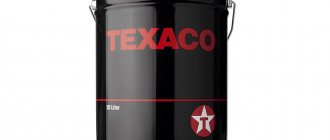Most motorists do not know what color motor oil should be. If this element has changed its color to amber or dark after a huge amount of travel, then there is no problem. A vehicle owner should only start to worry if the oil begins to foam or becomes too thick.
The color of used motor oil is usually dark, so there is no need to panic. Even if the lubricant material has become dark in color, it can still be ridden. Moreover, after a couple of hundred kilometers the oil is simply bound to change its color. If this does not happen, then it must be replaced, since the normal color of the engine oil during active use of the car only means that it is not coping with its tasks.
Darkening of the oil is not a reason to change it. In the vehicle documentation, the manufacturer usually indicates the intervals at which the lubricant is changed. It is best to follow these recommendations, also taking into account the individual characteristics of the car and its mode of use.
Oil color on dipstick
The color of the engine oil on the dipstick raises the most questions among motorists. Here everything depends not only on the type of lubricant used, but also the model of the vehicle, as well as the type of engine. When the power unit is in good working order, the engine oil is usually brown in color. If, when draining, the color is black or dark brown, then we can confidently say that the engine is out of order and cannot fully cope with its responsibilities.
One of the worst changes is thickening of the engine oil. If the lubricant has stopped flowing from the dipstick, and in appearance it resembles condensed milk, then it is necessary to change the oil as quickly as possible. Otherwise, the engine will run dry, which will significantly shorten its service life and may cause complete failure of the unit.
New oil
This is an ideal lubricant, without impurities. It has a standard viscosity and does not contain impurities. In practice, it is mixed with the remaining old oil immediately after being poured into the engine.
A few drops of the new oil were quickly absorbed into the paper, and after a while its traces became almost invisible.
Reasons for color change
Now it’s time to figure out what determines the color of motor oil. Any such product contains additives necessary to improve the properties of the oil. Additives also ensure the dissolution of products that appear during fuel combustion. This is why the oil takes on a blackish tint when the car is actively used.
You only need to worry if, even after driving the vehicle for a long time, the oil does not begin to change color. Novice motorists mistakenly believe that they have come across good oil and there are simply no contaminants in the power unit. However, the main reason is that the oil does not cope with its tasks, so you should immediately switch to a product of another brand.
Almost new oil (petrol engine 6,000 km)
This is oil drained from a new engine (vehicle mileage is 6000 km). The dark color of the oil is surprising, which can be explained by the fact that a large number of solid particles are formed in the combustion chambers of the unit.
Modern direct injection gasoline engines produce much more particulate matter than indirect injection units. Hence the rather rapid darkening of the oil.
Compliance Standards
The choice of engine oil must always comply with the international standards specified in the car manufacturer's manual. The main standards are as follows:
- SAE J300 . This standard describes the viscosity characteristics described in the previous section. Indicates low temperature and high temperature viscosity.
- API . This standard describes performance characteristics. Current gasoline categories are SJ, SL, SM, SN. Current diesel categories are CH-4, CI-4, CJ-4. The use of more modern categories in engines is permitted, but reverse use is excluded. Please note that most modern oils are universal, that is, they can be used in both gasoline and diesel engines. However, sometimes you can find compounds specifically designed for one or another type of engine, and this difference will be reflected in the API.
- ACEA . European standard. The car manual clearly states which categories of oils are allowed to be used in a particular engine. Therefore, when selecting engine oil, you need to look at the label markings, since certain engines and exhaust systems require specific technical requirements.
Is it worth changing the oil if the due date has come and it is still light?
Only a special chemical laboratory can determine the quality of a particular oil. Not a single mechanic at a service station can say for sure whether the lubricant needs to be changed or not, having determined its composition “by eye”.
The replacement must be made in accordance with the technical recommendations of the vehicle manufacturer. At the same time, the old standards of 10,000 km for passenger vehicles are not always appropriate, and not for all cars.
The oil may practically not change its color, but it must be drained after a certain time (number of kilometers traveled). Otherwise, it will begin to lose its performance characteristics very quickly. And this threatens partial or major engine repairs.
Source
Engine oil requirements
To ensure reliable and economical operation of power units, the oil must meet the established requirements. High quality motor oil should:
- Protect internal combustion engine parts from the accumulation of carbon deposits;
- Avoid coking of the piston rings;
- Possess high protective and anti-corrosion properties;
- Ensure maximum reduction of mechanical losses and ensure optimal fractional composition.
During long-term storage, the composition of the oil must be stable. Changing its operational properties is considered unacceptable.
Ways to recognize fake oil
Determining the quality of oil at home can only be done with a high degree of probability, but not with a 100% guarantee.
Important! Only specialists can give a 100% guarantee of oil quality, and not without the help of special instruments.
.
Methods for determining the authenticity of branded oil can be divided into the following three types:
- Before purchase;
- After the purchase;
- After changing the oil.
Next, we bring to your attention direct methods for determining the quality of motor oil.
Determining authenticity before purchasing oil
While the oil is still on the shelf or in a barrel at the oil change center, all that is available to the buyer is:
- Inspection of the canister;
- Possibility to put a few drops on your fingers.
If you plan to purchase oils in a canister, then you need to inspect the container itself and the label attached to it. First of all, everything should be neat, the soldering seams of the canister should be even, etc.
In addition, you need to pay attention to the markings that are applied to both the label and the canister. It indicates the date and time of production, as well as the batch number. If the data indicated on the canister and the label differ, then you are almost guaranteed to have a fake.
How to correctly read the label on a canister Important! If this data is not indicated on the label or canister, then perhaps this is provided by the manufacturer himself. In this case, it is advisable to look for the availability of this information on canisters of the same oil in other stores.
.
Gasoline engine (oil change mileage 10,000 km – engine mileage 70,000 km)
The oil was changed every 10,000 km. Despite the fact that 10 thousand km have passed since the oil change, the lubricant still protects the engine, although it contains an admixture of exhaust gases and gasoline. The presence of foreign substances in the oil can also be determined by smell by comparing the oil that has been used with new oil.
Dark oil, clearly worn, but worn within normal limits. A small admixture of light fractions is visible on the paper, but the oil leaves a homogeneous layer on the walls of the container.
Cold check
It happens that instead of high-quality synthetics, artisans pour cheap “mineral water” into cans and sell them at exorbitant prices. It can be distinguished by visual analysis of viscosity. If the canister says that the viscosity is 5W30 or 0W30, then this oil is capable of operating at low temperatures. “Semi-synthetic” has a viscosity of 10W40, “mineral” - 15W40. This means that synthetic oil works down to temperatures below -20 degrees below zero, while mineral water thickens already at -10 degrees. If you pour a little lubricating liquid into a flask and put it in the freezer of the refrigerator, then everything will be clear. If the substance being tested has thickened and stopped flowing freely, then it is “mineral water” poured into an expensive canister. True, such an analysis can be carried out after purchasing the product.
A flammable fake. Every third independent gas station sells counterfeit goods Read more
Some experienced car owners are able to determine the viscosity with their fingers. They drip oil onto the skin and rub it on the palm. Although this method is not suitable for beginners.
Foaming: what's the problem?
The formation of air bubbles can lead to various negative consequences:
- Reducing the viscosity of the lubricant composition;
- Slow removal of thermal energy, due to which the parts and components of the car will not be properly lubricated. The oil in the system moves through special channels of small diameter, and in order to lubricate the engine, high pressure must be maintained in them;
- Lack of proper cooling of power unit parts, leading to overheating;
- Friction between engine parts increases, which leads to their rapid wear. In the most advanced cases, this can lead to water hammer and major engine repairs.
The emulsion in the engine harms all its parts
Motor oil can foam for several reasons:
- Penetration of antifreeze into the lubrication system of transport due to damage to the gasket between the cylinder block and its head;
- Water entering the lubricant, which leads to a change in its chemical composition and the formation of an oil emulsion;
- Incompatibility of lubricants. When changing oil, it is impossible to completely drain the old oil, which can cause it to mix with the new one.
Depressurization of the cooling system
The reason for the appearance of foam in this case is the mixing of oil and antifreeze. In most cases, this occurs due to defects in the gasket located under the cylinder block cover. Antifreeze can mix with engine oil if there are defects in the parts. Cracks form in them due to metal fatigue or prolonged exposure to high temperatures.
Optimal time to change oil
It is believed that the optimal engine oil change interval for passenger cars is approximately 15 thousand kilometers. On average, this is from 200 to 300 operating hours under various operating conditions, with the exception of maximum load. This is mainly a suburban mode of operation with runs without frequent stops at an average speed of 70 km/h.
However, 15 thousand kilometers in the city can no longer be compared with 300 engine hours. The average speed in the urban cycle does not exceed 25 km/h, and a 30-kilometer journey in a metropolis often stretches for 1.5-2 hours. As a result, the power unit produces not 300, but 600 engine hours or more per year. At the same time, at low speeds it overheats and experiences much greater loads than at cruising speed. Therefore, when constantly driving in traffic jams, the oil must be changed twice as often, that is, after 6-7 thousand kilometers.
Leave a comment (0)
Color as an indicator of the properties of motor oil - true or false?
The color of the oil indicates how worn it is. Myth or truth? Should you change the oil as soon as it has lost its color? There are cars in which the oil changes color and transparency after 2-3 thousand km after changing it. In other cars, even after 15 thousand km, the oil is still amber-transparent. So what does the color of the motor oil used say? Is it possible to tell when it's time to change it by color?
- Did you know that recycled motor oil can be sent to a laboratory to determine the condition of your car's engine?
- Using a chemical test, you can also find out exactly when motor oil loses its protective properties. This allows you to find out exactly at what mileage to change the engine oil. An express test, as a rule, does not allow you to find out.
- The best thing we can do for our car's engine is to change the oil in a timely manner.
Used oil in a diesel engine looks different than oil in a gasoline engine. In the first case, the oil is usually black, in the second it is optional. In some gasoline engines running on gas, the oil practically does not turn black, that is, when you drain the used oil in such engines, you can see that it looks almost like new.
Motor oil is regularly heated to temperatures in excess of 100°C and "machined". All this causes a shift in its molecules. As a result, the oil changes its properties and parameters. But unfortunately, we cannot say anything by eye about the condition of the oil, since we cannot see how the formula of the molecules in the waste liquid has changed.
It is much easier to see what foreign substances have entered the oil. First of all, we are talking about fuel. The fuel enters the oil pan, flowing down the walls of the engine cylinders. The amount of fuel flowing down the cylinder walls increases when starting a cold engine. In the case of diesel engines, this occurs during regeneration of the diesel particulate filter. Under extremely unfavorable conditions, it is even possible to observe an increased oil level in the engine (oil-fuel mixture), despite the fact that a certain amount of oil is constantly being burned in the engine.
Solid particles also get into the oil: most of them (by volume) get into diesel engines and much less into gasoline engines. But the least amount of particulate matter gets into gasoline engines that run on gas. This is why the oil in diesel engines darkens very quickly, in gasoline engines - more slowly, and in some cars running on liquefied gas, it practically does not change its color.
See also: Here's why the oil pressure light on your dashboard won't save you from engine damage when your oil level is low
A small amount of solid particles in the oil does not mean that the liquid has not lost its properties. Quite the contrary. For example, in cars running on gas, despite the fact that the oil practically does not change its color, the liquid is subject to rapid degradation. This is due to acidic compounds formed during the combustion of gas in the combustion chamber of the engine: some of the acids leave the engine through the exhaust pipe, and some go into the oil. That's why some car manufacturers that equip some models with a gas-powered system from the factory require car owners to change their oil more frequently than non-gas-powered cars.
In addition, regardless of the type of fuel used in internal combustion engines, as a result of fuel combustion, products are always formed that also end up in the oil. Plus, by-products can form in the oil itself due to physical and chemical processes. A small amount of products formed during fuel combustion leaves the combustion chamber, burning along with the fuel. Some of the gases return to the engine crankcase. Moreover, the more worn out the engine is, the more various by-products are formed in it.
See also: Formula 1 engines burn motor oil to increase power
Did you know that you can take a sample of used oil from an engine and have it analyzed in a laboratory to determine what condition the car's engine is in (you can at least assess the condition of the engine liners)? Unfortunately, such laboratory analysis is expensive and does not always give a clear answer. In some cases, this test makes sense. But it is better to change the oil and oil filter more often.
There are also disposable oil testers on sale today, which (in theory) allow you to reliably assess the condition of the engine oil: determine whether it needs to be replaced. Typically, such one-time tests look like this: we take a drop of oil from the engine, apply it to an express strip and wait 10-30 minutes, after which we determine the degree of wear from the oil trace, comparing the trace with the template.
However, in practice, everything is not so simple: from the test strips you can easily notice that the oil you are using contains many foreign substances that are not present in the new oil. But nothing more. In general, this test is still similar to fortune telling on coffee grounds: oil stains indicate something, but it is not entirely clear what exactly it is about. Data indicating, for example, the condition of the engine is out of the question.
With a rapid test, however, you can easily tell whether the oil quickly loses its properties after changing. In addition, using an express oil condition test, you can experimentally find out when, after replacement, the oil begins to lose its properties. This may help to figure out when to change your oil.
Last year, a video appeared on the Internet where the authors demonstrated an unusual oil test: testing the fluidity of various oils on an inclined surface (for example, the test can be carried out on glass). So, if you drop new oil onto an inclined surface, its fluidity will be slightly different compared to the oil already used in the engine.
If you do a similar test with used oil (same viscosity and grade and temperature), you will see that the used oil flows down the plate at a different rate. This means that the viscosity of the oil used has changed. That is why when purchasing motor oil you need to pay attention to the viscosity grade. After all, the car owner must be sure that the oil really protects the car engine and has the correct parameters.
Many drivers like to rack their brains, constantly searching for the grail that would maximize engine life. But, unfortunately, most advice and opinions are a myth. The best thing we can do for our car's engine is to change the oil regularly. At least once a year and at least every 10,000 km.
And don't listen to dealers who say that your car needs an oil change every 15,000 km. For most even modern engines, an interval of 10 thousand km is the most suitable. Ideally, of course, if you use your car in the city (often driving short distances in winter), it is better to change the oil even more often. The fact is that city driving refers to difficult operating conditions of the car. Accordingly, the oil should be changed much more often than the manufacturer recommends.
The more often you change your oil, the better your engine will be. In this case, harmful impurities accumulate in it more slowly, which over time begin to settle on various elements of the motor.
How to eliminate and prevent lubricant thickening
- Regularly check the engine operating temperature;
- Check fuel combustion efficiency;
- Do not allow water and antifreeze to enter the oil;
- Use only high-quality original compounds recommended by a car dealer.
If the consistency of the oil has changed, you should immediately contact a car service center.
Changes in the color and consistency of engine oil can cause problems. Many of them can be eliminated on their own; to get rid of others, you will have to contact a car service. You can avoid malfunctions of a gasoline or diesel engine if you use only high-quality branded engine oil and follow the recommendations of the car manufacturer.
Source










